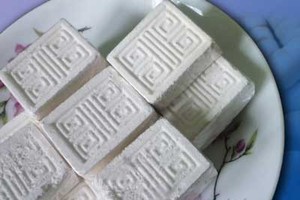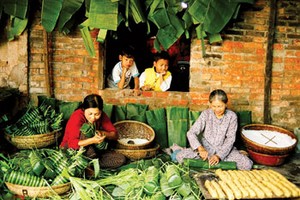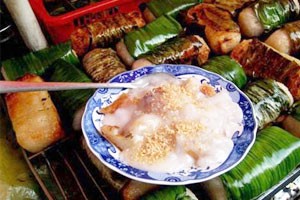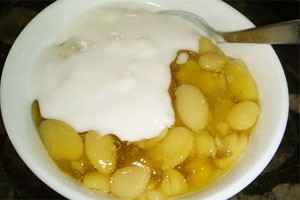March, the time when bees rushes around getting honey, when the grapefruit flowers blossoms in a snow-white color, I would find myself missing my mother’s areca spadix sweetened porridge.
che2.jpg)
Every time coming back home and watching my mother made areca spadix sweetened porridge, I am back to have so many feelings. They are not only the feeling of my mother and the dish she made, but also the honor for cultural value of the traditional cuisine that remains right in my family.
My childhood was full of the memory of the grapefruit flowers and the image of my mother. Far from home, I learned to treasure every moment with my family when I had a chance to come back, the chance to enjoy the appetizing dish my mother made - a small bowl of areca spadix sweetened porridge.
Yet, until now, I really notice the way my mother made the dish from the beginning to the end.
First, you have to choose the mung bean, the main ingredient of the dish. My mother prefers the small kind of bean, which is yellow and fragrant. Then she soaks the beans in the water for one night. After the beans had expanded, my mother told me to remove their shell, add some salt and steam the beans. We should be careful not to let the bean overdone or else they would be broken.
The most difficult step that I still could not do is to stir the flour. The flour my mother uses is the tapioca starch. She puts the flour into the water and stirs them. While stirring, she adds some grapefruit oil and continually stirs the mixture. This step is important since we have to be careful not to make the flour too old or too fresh or else it would have a bad effect on the porridge.
The next step is embalming the fragrance for the porridge; this is an indispensable step of the dish. My mother said that only to embalm the grapefruit flower can we make the sweetened porridge fragrant. For this stage, my mother uses a bowl since it is quite thin, which is appropriate to embalm.
The material for this particular stage is sand. After cleaning and drying the sand, my mother pours it into a broad flat frying basket, and then spreads out a tissue paper on the sand. Next, she puts the grapefruit flower on the paper and lays the bowl downward the flowers. That is the way to make the fragrance stagnate in the bowl.
One more interesting thing that I myself used to wonder when I was a child is why we call the dish the sweetened porridge of areca spadix while we use grapefruit flower. The reason, in fact, is very simple. That is because the beans in the sweetened porridge look just like the areca spadix, my mother explained.
The next step is spooning the flour into the bowl, and then putting the beans in the bowl; make sure that we do not make the bean sink and clot. Amazingly, the mung beans flow on the flour look just like the areca spadix on the surface of the lake. It really arouses a peaceful feeling.
Finally, my mother puts some coconut milk on the bowl, which makes the dish looks more appetizing and moreish. To me, the dish is not only special because of its delicious taste, but the love of my mother.
























